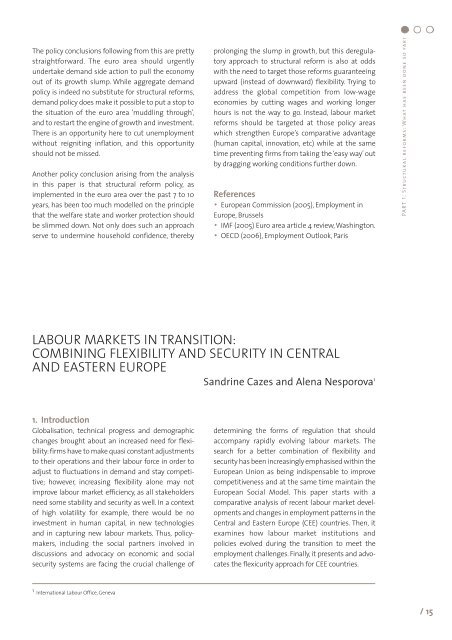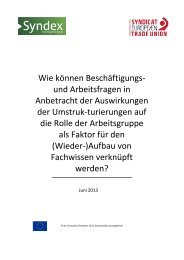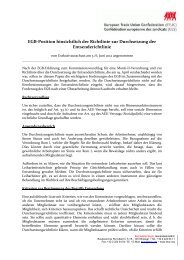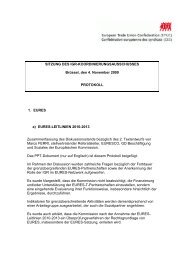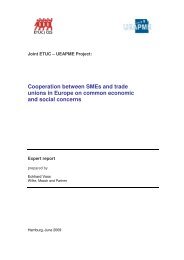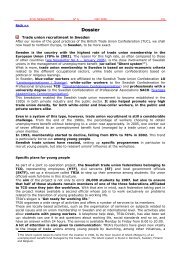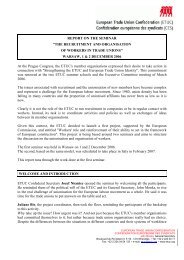Structural reforms and macro-economic policy - ETUC
Structural reforms and macro-economic policy - ETUC
Structural reforms and macro-economic policy - ETUC
Create successful ePaper yourself
Turn your PDF publications into a flip-book with our unique Google optimized e-Paper software.
The <strong>policy</strong> conclusions following from this are pretty<br />
straightforward. The euro area should urgently<br />
undertake dem<strong>and</strong> side action to pull the economy<br />
out of its growth slump. While aggregate dem<strong>and</strong><br />
<strong>policy</strong> is indeed no substitute for structural <strong>reforms</strong>,<br />
dem<strong>and</strong> <strong>policy</strong> does make it possible to put a stop to<br />
the situation of the euro area ‘muddling through’,<br />
<strong>and</strong> to restart the engine of growth <strong>and</strong> investment.<br />
There is an opportunity here to cut unemployment<br />
without reigniting inflation, <strong>and</strong> this opportunity<br />
should not be missed.<br />
Another <strong>policy</strong> conclusion arising from the analysis<br />
in this paper is that structural reform <strong>policy</strong>, as<br />
implemented in the euro area over the past 7 to 10<br />
years, has been too much modelled on the principle<br />
that the welfare state <strong>and</strong> worker protection should<br />
be slimmed down. Not only does such an approach<br />
serve to undermine household confidence, thereby<br />
prolonging the slump in growth, but this deregulatory<br />
approach to structural reform is also at odds<br />
with the need to target those <strong>reforms</strong> guaranteeing<br />
upward (instead of downward) flexibility. Trying to<br />
address the global competition from low-wage<br />
economies by cutting wages <strong>and</strong> working longer<br />
hours is not the way to go. Instead, labour market<br />
<strong>reforms</strong> should be targeted at those <strong>policy</strong> areas<br />
which strengthen Europe’s comparative advantage<br />
(human capital, innovation, etc) while at the same<br />
time preventing firms from taking the ‘easy way’ out<br />
by dragging working conditions further down.<br />
References<br />
• European Commission (2005), Employment in<br />
Europe, Brussels<br />
• IMF (2005) Euro area article 4 review, Washington.<br />
• OECD (2006), Employment Outlook, Paris<br />
LABOUR MARKETS IN TRANSITION:<br />
COMBINING FLEXIBILITY AND SECURITY IN CENTRAL<br />
AND EASTERN EUROPE<br />
S<strong>and</strong>rine Cazes <strong>and</strong> Alena Nesporova 1<br />
1. Introduction<br />
Globalisation, technical progress <strong>and</strong> demographic<br />
changes brought about an increased need for flexibility:<br />
firms have to make quasi constant adjustments<br />
to their operations <strong>and</strong> their labour force in order to<br />
adjust to fluctuations in dem<strong>and</strong> <strong>and</strong> stay competitive;<br />
however, increasing flexibility alone may not<br />
improve labour market efficiency, as all stakeholders<br />
need some stability <strong>and</strong> security as well. In a context<br />
of high volatility for example, there would be no<br />
investment in human capital, in new technologies<br />
<strong>and</strong> in capturing new labour markets. Thus, <strong>policy</strong>makers,<br />
including the social partners involved in<br />
discussions <strong>and</strong> advocacy on <strong>economic</strong> <strong>and</strong> social<br />
security systems are facing the crucial challenge of<br />
1 International Labour Office, Geneva<br />
determining the forms of regulation that should<br />
accompany rapidly evolving labour markets. The<br />
search for a better combination of flexibility <strong>and</strong><br />
security has been increasingly emphasised within the<br />
European Union as being indispensable to improve<br />
competitiveness <strong>and</strong> at the same time maintain the<br />
European Social Model. This paper starts with a<br />
comparative analysis of recent labour market developments<br />
<strong>and</strong> changes in employment patterns in the<br />
Central <strong>and</strong> Eastern Europe (CEE) countries. Then, it<br />
examines how labour market institutions <strong>and</strong><br />
policies evolved during the transition to meet the<br />
employment challenges. Finally, it presents <strong>and</strong> advocates<br />
the flexicurity approach for CEE countries.<br />
PART 1: <strong>Structural</strong> <strong>reforms</strong>: What has been done so far?<br />
/ 15


